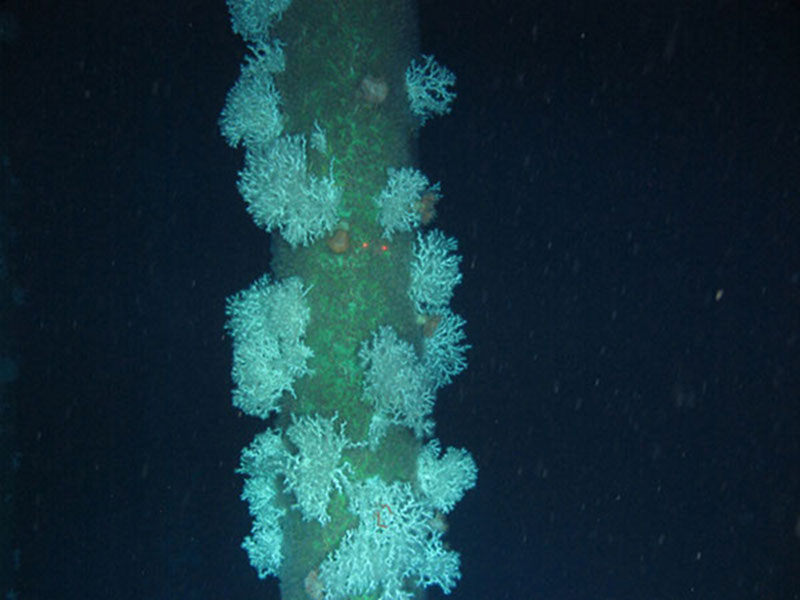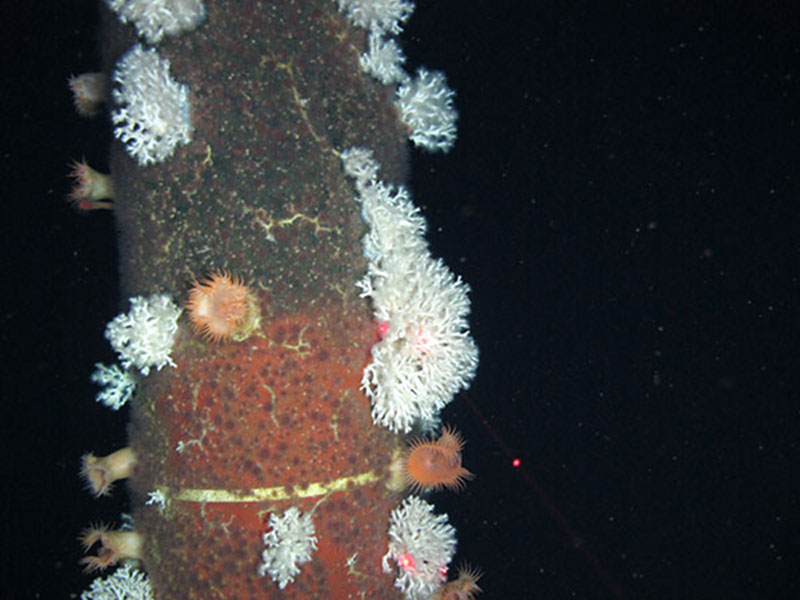
By Jay Lunden, Chief Scientist - Temple University
July 13-23, 2012

Lophelia pertusa growing on a tendon at Jolliet platform, a tension leg platform. Image courtesy of Lophelia II 2012 Expedition, NOAA-OER/BOEM. Download larger version (jpg, 1.9 MB).
During our final cruise as part of the Lophelia II project, we made some significant progress in our studies of coral communities in the deep Gulf of Mexico. Over the course of a little over a week at sea, we visited four deepwater oil and gas production platforms and one subsea installation. Using the Kraken II remotely operated vehicle (ROV) from the University of Connecticut, we surveyed these manmade structures for coral coverage and collected high-quality imagery and video, coral samples for genetic work, and water and sediment samples for related ecological studies. We were particularly interested in Lophelia pertusa, a deepwater stony coral that is one of the focal species of this project due to its wide geographic range and role in habitat formation.

Colonies of Lophelia pertusa growing on a test piling at the subsea well installation in Mississippi Canyon. Flytrap anemones and Eumunida picta squat lobsters are also present. Image courtesy of Lophelia II 2012 Expedition, NOAA-OER/BOEM. Download larger version (jpg, 2.3 MB).
We began our work in the western Gulf, where we visited the Baldpate and Jolliet platforms. Both of these platforms have different designs: Jolliet is a tension-leg platform and Baldpate is a compliant tower. We were very excited to see Lophelia growing on both structures. While the structures were different, we observed similar distributions of Lophelia at both locations. Future analyses of the images we collected will help us determine the corals’ growth rates and if they vary among the different types of structures. We also collected box core samples at Baldpate and Jolliet as part of our food web studies.
After finishing up our work in the western Gulf, we moved eastward and dove at a subsea well installation. This was unlike our previous dives, as the entire structure rose less than 150 feet off of the seafloor. We were able to collect numerous images at this station and deploy markers for future visits to measure growth and temporal community changes.

Tendon at Ram Powell platform showing numerous Lophelia pertusa colonies and flytrap anemones. We observed Lophelia at a maximum depth of 799 meters at Ram Powell – a new depth record for the Gulf of Mexico. Image courtesy of Lophelia II 2012 Expedition, NOAA-OER/BOEM. Download larger version (jpg, 1.9 MB).
Our greatest breakthrough on this cruise came at Ram Powell, a tension leg platform in the eastern Gulf that extends to 995 meters depth, making it one of the deepest platforms in the region. Here, we confirmed a new depth maximum for Lophelia in the Gulf: 799 meters. Prior to this cruise, the deepest known occurrence of Lophelia was at 630 meters in the Mississippi Canyon lease area of the Gulf. With this exciting discovery, we expanded our knowledge of Lophelia’s bathymetric range in the Gulf. Further, we can use the environmental data (temperature, oxygen, etc.) collected during the dive to better understand the environmental factors that govern the distribution of Lophelia.
The last dive of the cruise was at Cognac platform, a shallow (315 meters) yet old (34 years) solid platform. We were very excited to visit this platform due to its age. At the base of the platform, we saw expansive Lophelia colonies that almost resembled the natural reefs we see on authigenic carbonates. We spent a significant amount of time at Cognac scanning the platform’s sides to obtain distribution and density scans of Lophelia. We wrapped up the dive with making a few collections.
With our time at sea ending after the work at Cognac, we had to head back to Pensacola, Florida, to demobilize and prep the ship for its next mission. The ROV crew also had to begin preparations for their future work. Since we lost some dive time due to weather and a few mechanical issues, we had to skip our planned dive at VK906 to collect live animals. However, we still had a successful cruise and made significant progress in understanding the depth distribution of Lophelia and how manmade structures serve to support biological communities, an area of inquiry that will certainly continue in the deep sea as well as other environments.